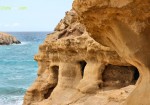Location
Kommos or Komos beach is located 70km south west of Heraklion city, between Kalamaki and Matala, in the Messara bay.
It’s a favorite destination for free campers, with juniper and tamarisk trees near the beach, offering rich shade to the guests.
Characteristics
| Access By: Car | Beach Type: Sand |
| Depth: Normal | Temperature: Cool |
| Organised: Yes | Crowded: Normal |
| Natural Shade: Yes | Windy: Yes |
| Family-friendly: Yes | Nudism-friendly: Yes |
Facilities
Umbrellas and sunbeds, showers, beach bar, restaurant.
Accommodation facilities can be found at the nearby villages of Kalamaki and Matala, or the inland ones of Pitsidia and Kamilari.
There is also an organised campsite between Pitsidia and Kommos.
Notes
Kommos is so wide and long that doesn’t get overcrowded even in the midst of August.
The waters are crystal clear and the breathtaking sunset over the islets of Paximadia is yet another reason for choosing Kommos.
In ancient times, Kommos was the port of Phaistos.
The ruins of this important Minoan settlement, founded around 2000 B.C., can be found very close to the beach.
This is the reason why the beach is a protected archaeological area and therefore building is forbidden.
Access to the archaeological site though is not allowed to the public.
The northern part of Kommos beach, succeeding the nearby of Kalamaki is called Potamos or Potamoserma and is preferred by nudists.
This part offers no facilities other than the rich shade of a few tamarisk trees.
Among the other special features of the beach are the huge sand dunes with lilies at the end of summer and the Caretta Caretta loggerhead nests that can be seen along the beach in which the eggs are incubated from May until September.
Walking on the beach of Kommos and the nearby of Kalamaki, you can easily see the nests, which are signaled and protected.
For those of you who would like to find more about the Caretta Caretta loggerhead turtles, visit the Archelon Sea Turtle Protection Society kiosk in nearby Matala.
Just opposite the archaeological site, in the sea, you will see a beautiful big rock called Volakas.
Legend has it that the stone is the top of the mountain that the blinded cyclope Polyphemus threw towards the ship of Odysseus to prevent him from escaping from Polyphemus’ cave.
The beach is very much affected by the strong westerly winds blowing at the whole beachfront of Messara so on those days you need to be extra careful not to slip on the slabs when entering the sea.
How to get to Kommos
From Heraklion to Kommos by car:
Access from Heraklion is possible by rented or private cars and motorbikes.
Kommos beach is 70km south of Heraklion.
Take the road to Tymbaki and Moires.
After Moires, continue to the village of Pitsidia and Matala.
Drive through Pitsidia and then follow the sign to the Kommos Archaeological Site.
When you arrive there you may park your car right next to the Kommos Archaeological Site right in front of the beach.
From Chania and Rethymno to Kommos by car:
Access from Chania and Rethymno is possible by rented or private cars and motorbikes.
Kommos is a little bit more than 1 hours drive from Rethymno and 2 hours from Chania.
Take the road to Agia Galini.
Continue to Tymbaki, drive past the town and turn off towards the village of Kamilari.
Continue until you find the road to Pitsidia and Matala.
Drive through Pitsidia and then follow the sign to the Kommos archaeological site.
When you arrive there you may park your car right next to the Kommos archaeological site and in front of the beach.
Note:
Please note that it is not possible to reach Kommos by public transport. You can get to the nearby towns of Moires, Tymbaki or Matala by daily buses from Heraklion.















